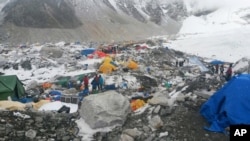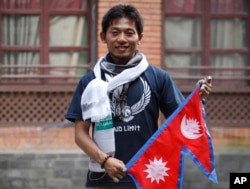Four months after a deadly earthquake, Nepal is struggling to revive mountain and trekking tourism, a vital source of jobs and income for the poor Himalayan country.
In Nepal, Ramesh Prasad Dhamala of Ecological Treks was excited as he prepared to welcome his first group of hikers since the devastating April 25 earthquake prompted thousands of mountaineers to pack up and leave.
“We are sending six German people to the mountains,” he said. “Similarly other companies, they are also doing. So a few trekkers, they are already starting their trekking activity on the mountain. They are not worried, they are ready to go.”
The men and women are among a handful of foreign climbers who are braving Nepal’s mountains this autumn after setting aside concerns about the instability of popular trails following the earthquake in the high Himalayas.
It’s a huge step forward as the country tries to woo back the more than 150,000 hikers who come every year to scale its peaks or trek in the tall mountains.
Making the mountains safe
The earthquake struck at the height of the spring climbing season and sent foreign climbers scurrying back. Nineteen people died after an avalanche struck Mount Everest and some popular trekking trails were damaged.
Ang Tshering, president of the Nepal Mountaineering Association, said in recent months they have worked hard to open up the mountains for visitors.
“We are repairing the trails, bridges and road heads,” he said. “Some of the places we are putting retention walls, where there are landslides. We are very much sure this will be very stable. Teahouses and lodges are not much affected. ”
The efforts are paying off. The California-based engineering firm Miyamoto International which was hired to address safety concerns, found trails around Mount Annapurna safe for hikers. It is due to give a report on Everest shortly. The two mountains account for about 70 percent of the climbers and hikers who head to Nepal.
That has raised hopes that 2016 will be a better year for the nearly 200,000 sherpas, guides, porters and others involved in the mountaineering trade. With the spring climbing season shattered by the earthquake, many of them had no income this year. But they hope the lure of the mountains will draw visitors back.
One of Nepal’s most accomplished mountaineers, Pemba Gyalje, is confident that the daunting, snowbound peaks will work their magic. Gyalje was hailed as a hero after he saved several climbers on the world’s second highest mountain, K2, in 2008. He has scaled Everest seven times.
“The mountain attraction is very unique and very powerful,” he said. “This is a very unique, natural power. It is very difficult to explain. I have a big hope to revive and to reestablish trekking and mountaineering as soon as possible.”
First post-quake climber sets sites on Everest
The proof of that attraction is Japanese climber Nobukazu Kuriki -- who is the first person setting out to conquer Everest after the earthquake. He begins his climb next month in a season that is far more challenging than spring.
A group of sherpas has begun repairing a treacherous stretch on the route known as the Khumbu Icefall which was destroyed in the earthquake. Kuriki said his mission is to contribute to the revival of mountain tourism and send out a message: Nepal is safe.
It is a message that many leading overseas travel companies are also sending out to their clients. Fiona Marshall of Britain-based KE Adventure Travels said the company has decided to operate in Nepal this autumn, following a careful assessment of areas where it operates.
Marhsall said Adventure Travels is already making bookings, and although demand is not the same as it would normally be, she expects it to bounce back.
“A lot of them are people who have been to Nepal before and they know the country, and they understand the geography, and they are keen to carry on,” she said.
And those who have spent decades developing the industry, such as Tshering, are confident that Nepal’s remote mountains have helped the tiny country make many friends around the world.
“I receive a lot of emails and calls from mountaineering communities as well as adventure communities and they have big sympathy to Nepal and they know that to help Nepal in the best way is to send people, so that each dollar they spend will help to revive the economy,” he said. “They are encouraging us that they will promote Nepal more than other years. ”
For Nepal, the revival of mountain tourism is crucial to its efforts to recover from the earthquake. The millions of dollars brought in by overseas trekkers and hikers are a valuable source of foreign exchange.








